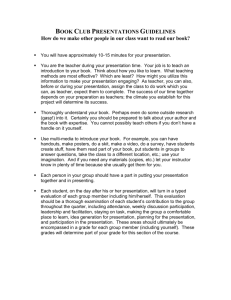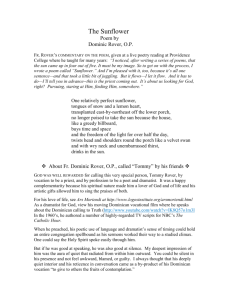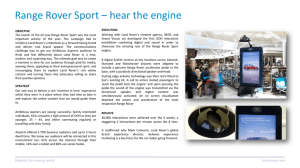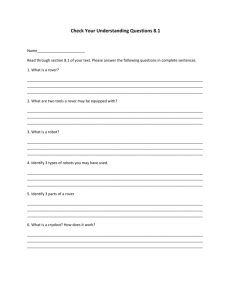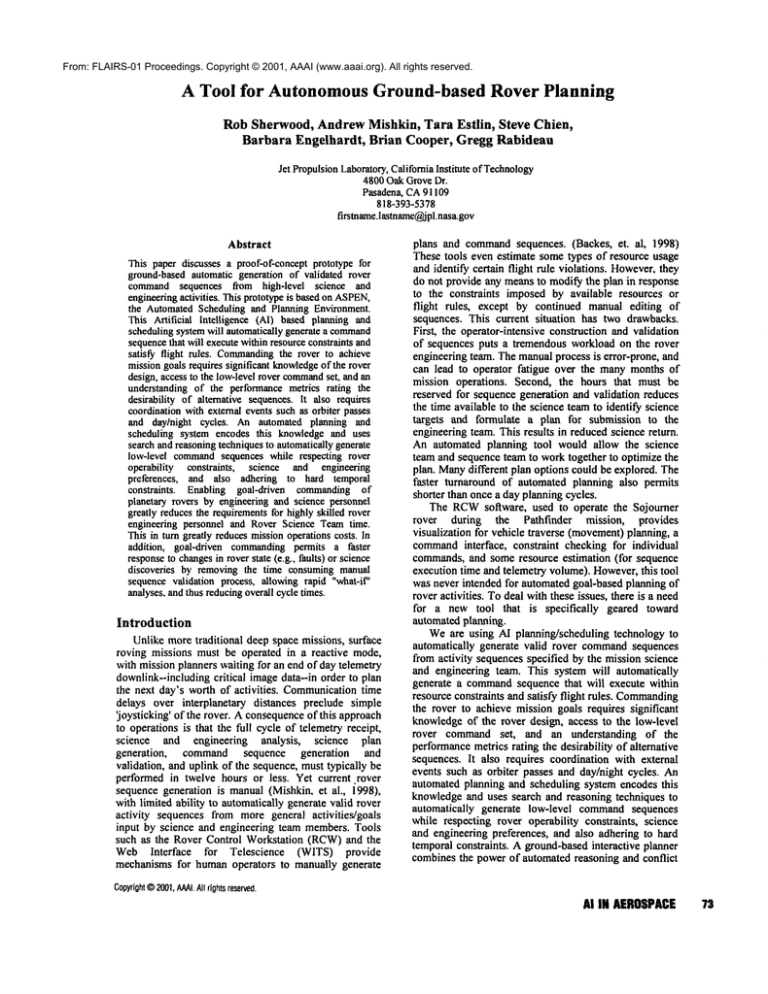
From: FLAIRS-01 Proceedings. Copyright © 2001, AAAI (www.aaai.org). All rights reserved.
A Tool for Autonomous Ground-based Rover Planning
Rob Sherwood, Andrew Mishkin, Tara Estlin, Steve Chien,
Barbara Engelhardt, Brian Cooper, Gregg Rabideau
Jet Propulsion Laboratory, California Institute of Technology
4800 Oak Grove Dr.
Pasadena, CA9 i 109
818-393-5378
firsmame.lastname@jpl.nasa.gov
Abstract
Thispaperdiscussesa proof-of-concept
prototypefor
ground-based
automaticgenerationof validated rover
command
sequences from high-level science and
engineering
activities. Thisprototypeis basedonASPEN,
the Automated
Schedulingand PlanningEnvironment.
ThisArtificial Intelligence (AI) basedplanningand
scheduling
systemwill automatically
generatea command
sequence
that will executewithinresourceconstraintsand
satisfy flight rules. Commanding
the roverto achieve
missiongoalsrequiressignificantknowledge
of the rover
design,accessto the low-levelrovercommand
set, andan
understandingof the performance
metrics rating the
desirabilityof alternativesequences.It also requires
coordination
withexternaleventssuchas orbiter passes
and day/night cycles. An automatedplanning and
schedulingsystemencodesthis knowledgeand uses
searchandreasoning
techniques
to automatically
generate
low-levelcommand
sequenceswhile respecting rover
operability constraints, science and engineering
preferences,and also adhering to hard temporal
of
constraints. Enabling goal-driven commanding
planetaryrovers by engineeringand sciencepersonnel
greatlyreduccsthe requirements
for highlyskilled rover
engineeringpersonneland RoverScienceTeamtime.
Thisin turn greatlyreducesmissionoperationscosts. In
addition, goal-driven commanding
permits a faster
response
to changes
in roverstate (e.g., faults)or science
discoveries by removingthe time consumingmanual
sequencevalidationprocess,allowingrapid "what-iV’
analyses,andthusreducing
overallcycletimes.
Introduction
Unlikemoretraditional deepspace missions, surface
roving missions must be operated in a reactive mode,
with missionplannerswaitingfor an endof day telemetry
downlink--including
critical imagedata-in order to plan
the next day’s worthof activities. Communication
time
delays over interplanetary distances preclude simple
~joysticking’of the rover. A consequence
of this approach
to operationsis that the full cycle of telemetryreceipt,
science and engineering analysis, science plan
generation, commandsequence generation and
validation, and uplink of the sequence,musttypically be
performedin twelve hours or less. Yet current .rover
sequencegeneration is manual(Mishkin,et al., 1998),
withlimited ability to automaticallygeneratevalid rover
activity sequencesfrom moregeneral activities/goals
input by science and engineering team members.Tools
such as the Rover Control Workstation(RCW)and the
WebInterface for Telescience (WITS) provide
mechanismsfor humanoperators to manuallygenerate
plans and command
sequences. (Baekes, et. at, 1998)
Thesetools evenestimate sometypes of resource usage
and identify certain flight rule violations. However,
they
do not provide any meansto modifythe plan in response
to the constraints imposedby available resources or
flight rules, except by continued manualediting of
sequences. This current situation has two drawbacks.
First, the operator-intensiveconstructionand validation
of sequences puts a tremendousworkloadon the rover
engineeringteam. Themanualprocessis error-prone,and
can lead to operator fatigue over the manymonthsof
mission operations. Second, the hours that must be
reservedfor sequencegenerationand validation reduces
the time availableto the scienceteamto identify science
targets and formulate a plan for submission to the
engineeringteam.This results in reducedsciencereturn.
Anautomated planning tool wouldallow the science
teamand sequenceteamto worktogether to optimizethe
plan. Many
different plan options couldbe explored.The
faster turnaround of automatedplanning also permits
shorter than oncea dayplanningcycles.
The RCW
software, used to operate the Sojourner
rover during the Pathfinder mission, provides
visualization for vehicle traverse (movement)
planning,
command
interface, constraint checkingfor individual
commands,
and someresource estimation (for sequence
executiontime and telemetryvolume).However,
this tool
wasnever intended for automatedgoal-basedplanningof
roveractivities. Todeal withthese issues, there is a need
for a new tool that is specifically geared toward
automatedplanning.
Weare using AI planning/schedulingtechnologyto
automatically generate valid rover command
sequences
fromactivity sequencesspecified by the missionscience
and engineering team. This system will automatically
generate a command
sequencethat will execute within
resourceconstraints and satisfy flight rules. Commanding
the rover to achieve missiongoals requires significant
knowledgeof the rover design, access to the low-level
rover commandset, and an understanding of the
performance
metricsrating the desirability of alternative
sequences.It also requires coordination with external
events such as orbiter passes and day/night cycles. An
automatedplanning and scheduling systemencodesthis
knowledgeand uses search and reasoning techniques to
automatically generate low-level command
sequences
while respecting rover operability constraints, science
and engineeringpreferences, and also adheringto hard
temporalconstraints. A ground-based
interactive planner
combinesthe powerof automatedreasoningand conflict
Copyright
©2001,
A,a,
AI.Allrights
reserved.
AI IH AEROSPACE
resolution techniqueswith the insights of the Science
Teamor PrincipalInvestigator(PI) to prioritize and reprioritize missiongoals.
ASPEN Planning System
Planning and scheduling technology offers
considerable promisein automatingrover operations.
Planning and scheduling rover operations involves
generating a sequenceof low-level commands
from a set
of high-levelscienceandengineeringgoals.
ASPEN
(Chien, et al., 2000) is an object-oriented
planningand schedulingsystemthat providesa reusable
set of software componentsthat can be tailored to
specific domains.Thesecomponents
include:
¯ An expressive constraint modelinglanguageto
allowthe user to define naturally the application
domain
¯ A constraint management
systemfor representing
and maintainingspacecraft and rover operability
and resource constraints, as well as activity
requirements
¯ Aset of search strategies for plan generationand
repair to satisfy hardconstraints
¯ A languagefor representing plan preferencesand
optimizingthese preferences
¯ Asoft, real-timereplanningcapability
¯ A temporal reasoning systemfor expressing and
maintainingtemporalconstraints
¯ A graphical interface
for visualizing
plans/schedules (for use in mixed-initiative
systemsin whichthe problemsolving process is
interactive).
In ASPEN,the main algorithm for automated
planningand schedulingis basedon a techniquecalled
iterative repair (Zweben
et al., 1994).Duringiterative
repair, the conflicts in the scheduleare detected and
addressedoneat a timeuntil conflicts nolongerexist, or
a user-definedtimelimit has beenexceeded.Aconflict is
a violation of a resource limitation, parameter
dependencyor temporal constraint. Conflicts can be
repaired by meansof several predefined methods. The
repair methodsare: movingan activity, adding a new
instanceof an activity, deletingan activity, detailing an
activity, abstracting an activity, makinga resource
reservation of an activity, canceling a reservation,
connecting a temporal constraint, disconnecting a
constraint, and changinga parametervalue. The repair
algorithmmayuse any of these methodsin an attemptto
resolvea conflict. Howthe algorithmperformsis largely
dependenton the type of conflict beingresolved.
Rover knowledgeis encoded in ASPEN
under seven
core modelclasses: activities, parameters, parameter
dependencies, temporal constraints, reservations,
resources and state variables. An activity is an
occurrenceover a time interval that in somewayaffects
the rover. It can represent anything froma high-level
goal or request to a low-level event or command.
Activities are the central structures in ASPEN,
and also
the mostcomplicated.Together,these constructs can be
74
FLAIRS-2001
usedto define rover procedures,rules and constraints in
order to allow manualor automaticgeneration of valid
sequences
of activities, also called plansor schedules.
Oncethe types of activities are defined, specific
instancescanbe createdfromthe types. Multipleactivity
instancescreated fromthe sametype mighthavedifferent
parametervalues, includingthe start time. Manycameraimagingactivities, for example,can be created fromthe
same type but with different image targets and at
different start times. Thesequence
of activity instancesis
whatdefinesthe plan.
Theflight rules andconstraintsare definedwithinthe
activities. Theflight rules can be defined as temporal
constraints, resource constraints, or system state
constraints. Temporalconstraints are defined between
activities. Anexamplewouldbe that the rate sensormust
warmup for twoto three minutesbefore a rover traverse.
In ASPEN,this would be modeled within the "move
rover" activity
as shown in Figure I. The
rate_sensorheat_.upis anotheractivity that is presumed
to turn ona rate sensorheater.
Constraintscanalso be state or resourcerelated. State
constraintscan either require a particular state or change
to a particular state. Resourceconstraints can use a
particular amountof a resource. Resources with a
capacity of one are called atomicresources. ASPEN
also
uses non-depletable and depletable resources. Nondepletableresourcesare resourcesthat can used by more
than one activity at a time and do not need to be
replenished.Eachactivity canuse a different quantityof
the resource. Anexamplewouldbe the rover solar array
power. Depletable resources are similar to nondepletableexceptthat their capacityis diminishedafter
use. In somecases their capacity can be replenished
(memory
capacity) and in other cases it cannot (battery
energy, i.e. non-rechargeable primary batteries).
Resource and state constraints are defined within
activities using the keyword
"reservations."See Figure1
for an example.
Activity move_rover{
constraints=
starts after end_ofrate_sensor_heat_up
by [2m,3m];
reservations=
solar_array_power
use 35,
rate_sensor_statechange_to"on",
target_state must_be"ready";
Figure I - ASPENModeling Language Example
The job of a planner/scheduler, whethermanualor
automated,is to accept high-level goals and generatea
set of low-levelactivities that satisfy the goalsanddo not
violate any of the rover flight rules or constraints.
ASPEN
provides a Graphical User Interface (GUI)for
manual generation and/or manipulation of activity
sequences.Figure2 contains a screen dumpof the GUI.
ASPENRover Model Description
The focus of our past and current workhas been to
comparethe automated ground-basedcommanding
tool
to the manual commanding process of the Mars
Pathfinder Sojourner rover. The majority of this work
was to create a rover model using the ASPEN
planning
system. The Sojourner planning model was built to a
level at which all flight rules and constraints could be
implemented. The resources include the three cameras,
Alpha Proton X-Ray Spectrometer
(APXS), APXS
deploy motor, drive motors, solar array, battery, RAM
usage, and EEPROM
usage.
Figure
2 - ASPENGUI
Thereare 27 different state variables used to track the
status of various devices, modes, and parameters. Some
of these parameters map directly onto rover internal
parameters and others are related to the ASPEN
specific
model. Weare not modelingall rover internal parameters
because manyare not required for constraint checking.
Wehave defined 162 activities of which 63 decompose
directly into low-level rover commands.
There are several constraints that affect overall
operations of the Sojourner rover. These include:
¯ Earth-Mars one-way communications time delay
(5-20 minutes)
¯ Limited communications bandwidth (generally
10 Mbits downlinkper sol I available to rover)
(1
¯ Limited communications opportunities
commanduplink, 2 telemetry downlinks per sol)
The power system is the single most important
resource for the Sojourner Rover. This system consists of
a .22 square meter solar array and 9 LiSOCLbatteries.
The batteries on Sojourner are primarily used during the
night for APXSdata collection.
They are primary
batteries
and therefore modeled as non-renewable
depletable resources. The solar array is the primary
power source used during the day. The predicted
available solar power profile throughout the Mars day
must be input before planning begins. Using a daffy
model is required due to changing solar array power
available
as a result of degradation from dust
accumulation and seasonal solar irradiation variability.
The angle of the solar array, which depends on the
terrain, will also affect the availability of solar energy.
1
A Sol is a Martian day, equivalent
minutes
to about 24 hours and 39
Solar array angle estimates could be generated by RCW
for input into ASPEN.
A typical Mars day might involve a subset of the
followingactivities:
¯
Complete an APXSdata collection
that was
carried out during the prior night
¯
Capture a rear image of the APXSsite
¯
Traverse to an appropriate site and perform a
series of soil mechanics experiments, including
several subframe images of soil mounds and
depressions created by running individual wheel
motors
¯
Traverse to a designated rock or soil location
¯
Place the APXSsensor head
Capture end-of-day operations images with its
forward cameras
* Begin APXSdata collection
¯
Shut downfor the night
APXSdata collection usually occurs overnight while
the rover is shutdown. Each of these activities can be
input into ASPEN
as a goal for that Mars day planning
horizon. The format of the input goals is RMLor Rover
ModelingLanguage. RMLis an application of Extensible
MarkupLanguage (XML)designed specifically for rover
operations. RCW
uses RML
for input and output.
The exact position of the rover after a traverse
activity is subject to dead reckoning error. The timing of
traverse activities is also non-determinant.Becauseof the
inherent problems of coordinating activities betweenthe
event-based rover and time-based lander, wait commands
are used to synchronize activities. Whenthe lander is
imaging the rover after a traverse, a wait commandis
used to ensure the rover will remain stationary at its
destination until the lander completes imaging. Because
the rover executes commands
serially, this ensures that
another commandwill not start execution before the
previous commandhas completed. All rover traverse
goals are generated using the RCW.(ASPENis not
designed to perform rover motion planning.) The RCW
operator can fly a 3-D rover icon through the
stereoscopic display of the Martian terrain. By inspecting
the stereo scene, as well as placing the rover icon in
various positions within the scene, the operator can
assess the trafficability of the terrain. Byplacing the icon
in the appropriate position and orientation directly over
the stereo image of the actual rover on the surface, the
rover’s location and heading are automatically computed.
This position information is output to ASPEN
to set the
rover end position state. The rover driver specifies the
rover’s destinations by designating a series of waypoints
in the scene, generating waypoint traverse commands.
Rover data storage is a scarce resource that must be
tracked within the ASPENmodel. The largest consumer
of data storage is the cameraimageactivity. This activity
can fill the on-board data storage if a telemetry session
with the lander is not available during the data collection.
ASPEN
will keep track of the data storage resource to
ensure that all data is downlinkedbefore the buffer is
completelyfull.
AI IN AEROSPACE 76
Status
Initial work in 1998 consisted of a preliminary proof
of concept demonstration in which we used automated
planning and scheduling technology integrated with
WITSto demonstrate automated commanding for the
Rocky-7rover from the WITSinterface. (Backes, et al.,
1999) In 2000, we are providing an in-depth validation
of the automated command-generation concept. The
ASPENplanning and scheduling
system will be
integrated with the Rover Control Workstation (RCW)
and WITS. ASPENwill receive RMLformatted highlevel requests from the activity interface. ASPEN
will
then automatically generate validated rover-command
sequences that satisfy these requests and provide those
RMLformatted sequences to the Rover Control
Workstation. The ASPENJava-based interface will
enable the user to access planned activities and to
observe resource and state constraints. The computation
intensive aspects of the commanding
capability (such as
the planner/scheduler,
path planner, uncertainty
estimation software, vision and image processing
software, etc.) will reside on one or more rover
workstationsbased in a central location.
Position, move
commands
MoveGoals ]
generate commandsmore frequently than once-per-day,
if communicationsopportunities permit.
The next level of testing involved generating plans
for two typical Sojourner rover days on Mars. These
plans were compared with the manually generated
sequences that were run during the Sojourner mission.
The commandsequences were very similar. The results
are summarizedin Table 1. Both days produced results
very quickly. However,it was a lengthy process (about
10 work weeks) to produce a model that contained
constraints and flight rules from a mission not designed
for automated planning. Manyof the commandswere
built into macros, which were basically mini-sequences.
There was not enough flexibility to utilize all the
capabilities of ASPEN
in building these plans. If the
operations of a mission are designed with an automated
planning system in mind, the model building time could
be reduced significantly.
Sol 18
Sol 28
Numberof Activities
197
110
Planning Time
41 seconds
6 seconds
Table I - Test Results
Eventually we would like to add performance metrics
to the planner model to optimize the generated plans.
This will enable automated"what-if’ analysis to generate
plans that maximizescience and engineering value.
Mars Exploration Rover
InitialState:
power,data
Environment:
thermal,solar
ASPEN
Plan
RoverModel:
activities,
resources,
constraints
Binary
command
sequence
Figure 3 - End-to-End Commanding System
The end-to-end data flow for this system is shownin
Figure 3. The interaction between ASPENand RCWis
an iterative process. Both ASPEN
and RCW
will receive
high-level goals. The RCW
input goals will be related to
rover motion. RCWwill output traverse commandsfor
input into ASPEN.ASPEN
will merge these with other
science and engineering goals to produce an intermediate
level plan. The plan will be output to RCW
to update
motion commands as necessary. This process will
continue until an acceptable plan is generated. Finally a
time ordered list of commandswould be output for
sequence generation.
Initial testing on the Sojourner ASPEN
model with a
representative set of 136 activities produced a conflict
free plan in about 9 seconds. This testing was completed
on a SunUltra-2 workstation. These relatively quick plan
cycles will allow the Sojourner Rover operations team to
perform "what-if’ analysis on different daily plans. Our
goal is that this quick planning capability will be used to
76
FLAIRS-2001
The goal of this automated planning work is a
deploymenton a future mission such as the 2003 rovers.
With far greater mobility than the 1997 Mars Pathfinder
rover, these robotic explorers will be able to trek up to
100 meters (about 110 yards) across the surface each
Martian day. Each Mars 2003 rover will carry a
sophisticated set of instruments that will allow it to
search for evidence of liquid water that may have been
present in the planet’s past. (See Figure 4.) The rovers
will be identical to each other, but will land at different
regions of Mars.
Figure 4 - Mars Exploration Rover
Both rovers are planned for launch from Cape
Canaveral, Florida, during June 2003 for an early 2004
arrival. The landed portion of the Mars Exploration
Rover mission features a design dramatically different
from Mars Pathfinder’s. WherePathfinder had scientific
instrumentson both the lander and the Sojournerrover,
these larger roverswill carry their instrumentswiththem.
Usingimagesandspectra taken daily fromthe rovers,
scientists will command
the vehicleto go to rockand soil
targets of interest and evaluate their compositionand
their texture at microscopic
scales. Initial targets maybe
close to the landingsites, but later targets can be far
afield: Theseexploration rovers will be able to travel
almost as far in one Martianday as the Sojournerrover
didoverits entirelifetime.
Rocksand soils will be analyzedwith a set of five
instrumentson each rover, and a special tool called the
rock abrasion tool, or "RAT,"will be used to expose
fresh rock surfaces for study. Eachrover has a massof
nearly 150 kilograms(about 300pounds)and has a range
of up to 100meters(about 110yards) per sol, or Martian
day. Surfaceoperations will last for at least 90 sols,
extendingto late April 2004, but couldcontinuelonger,
dependingonthe health of the vehicles.
Onboard Rover Planning
In addition to the work with Sojourner, we are
developing a dynamic, onboard planning system for
rover sequence generation. The CASPER
(Continuous
Activity Scheduling, Planning, Execution and Replanning)system(Chienet al., 1999;Chienctal., 2000),
is a dynamicextension to ASPEN,
which can not only
generate rover commandsequences but can also
dynamically modify those sequences in response to
changingoperatingcontext. If orbital or descentimagery
is available, CASPER
interacts with a path planner to
estimate traversal lengths and to determineintermediate
waypoints that are needed to navigate around known
obstacles.
Oncea plan has been generated it is continuously
updatedduring plan executionto correlate with sensor
and other feedbackfrom the environment.In this way,
the planneris highly responsiveto unexpectedchanges,
suchas a fortuitous event or equipmentfailure, and can
quickly modifythe plan as needed. For example,if the
rover wheelslippage has caused the position estimate
uncertainty to grow too large, the planner can
immediately command
the rover to stop and perform
localization earlier than originally scheduled.Or, if a
particular traversal has used morebattery powerthan
expected, the planner mayneed to discard one of the
remaining science goals. CASPER
has been integrated
with control software fromthe JPL Rocky7 rover (Volpe
et al., 2000)and is currently beingtested on Rocky7 in
the JPL MarsYard.
Conclusions
Currentapproachesto rover-sequencegeneration and
validation are largely manual,resulting in an expensive,
labor, and knowledgeintensive process. This is an
inefficient use of scarce sciencc-Pland key engineering
staff resources. Automation
as targeted by this tool will
automatically generate a constraint and flight rule
checkedtime ordered list of commands
and provides
resourceanalysis options to enableusers to performmore
informativeandfast trade-offanalyses.Initial tests have
shownplanningtimes on the order of secondsrather than
hours. Additionally, this technology will coordinate
sequencedevelopmentbetweenscience and engineering
teamsand wouldthus speedup the consensusprocess.
Enabling goal-driven commandingof planetary
rovers by engineering and science personnel greatly
reduces the workforcerequirementsfor highly skilled
rover engineeringpersonnel. Thereductionin teamsize
in turn reduces missionoperations costs. In addition,
goal-driven commanding
permits a faster response to
changesin roverstate (e.g., faults) or sciencediscoveries
by removing the time consuming manual sequence
validation process, allowing"what-if"analyses, andthus
reducingoverall cycletimes.
Acknowledgement
The TMOD
TechnologyProgramfunded the research
described in this paper. All workwasperformedat the
Jet Propulsion Laboratory, California Institute of
Technology, under a contract with the National
Aeronauticsand SpaceAdministration.
Bibliography
P. Backes, K. Tso, and G. Tharp. "MarsPathfinder
mission Internet-based operations using WITS.
ProceedingsIEEEInternational Conferenceon Robotics
and Automation,"pages 284-291,Leuven, Belgium,May
1998.
P. Backes, G. Rabideau, K. Tso, S. Chien,
"AutomatedPlanning and Scheduling for Planetary
RoverDistributed Operations,"Proceedingsof the IEEE
Conference on Robotics and Automation (ICRA),
Detroit, Michigan,May1999.
S. Chien, R. Knight, A. Stechert, R. Sherwood,G.
Rabideau, "Integrated Planning and Execution for
AutonomousSpacecraft", Proceedings of the IEEE
AerospaceConference(IAC), Aspen,CO,March1999.
S. Chien, R. Knight, A. Stechert, R. Sherwood,and
G. Rabidcau, "Using Iterative Repair to ImproveResponsivenessof Planningand Scheduling," Proceedings
of the 5th Intl. Conferenceon Artificial Intell-igence
Planningand Scheduling,Breckenridge,CO,April 2000.
S. Chien, G. Rabideau, R. Knight, R. Sherwood,B.
Engelhardt,D. Mutz,T. Estlin, B. Smith,F. Fisher, T.
Barrett, G. Stebbins, D. Tran , "ASPEN
- Automating
SpaceMissionOperationsusing AutomatedPlanningand
Scheduling,"SpaceOps,Toulouse,France, June 2000.
A. Mishkin, J. Morrison, T. Nguyen,H. Stone, B.
Cooper, B. Wilcox, "Experienceswith Operations and
Autonomyof the Mars Pathfinder Microrover,"
proceedings of the 1998 IEEEAerospaceConference,
March21-28 1998, Snowmass
at Aspen,Colorado.
R. Volpe, T. Estlin, S. Laubach,C. Olson, and J.
Balaram, "Enhanced Mars Rover Navigation
Techniques"To appear in the Proceedingsof the IEEE
International Conferenceon Robotics and Automation,
SanFrancisco, CA,April 2000.
Zweben,M., Daun, B., Davis, E., and Deale, M.,
"Schedulingand Reschedulingwith Iterative Repair,"
Intelligent
Scheduling, Morgan Kaufmann, San
Francisco,1994, pp. 241-256.
AI IN AEROSPACE77


